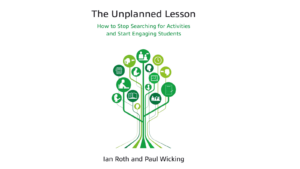By Giuseppe Carone
Juliet: ‘What’s in a name? That which we call a rose
By any other name would smell as sweet.’
(‘Romeo and Juliet’, Act II, Scene 2, 1594-1596, )
by : William Shakespeare.
When a writer plans a book, s/he jots down notes, maybe its main components, such as theme, plot, characters, setting, and then s/he weaves these ideas to become different strands of the story, which at the end becomes the novel. To use a book as a didactic tool to teach or learn English, the reader or the teacher must do exactly the opposite and disassemble the book or play into its original components.
The aim of this short and modest article is to analyse the book “I Owe You One”, written by Sophie Kinsella and published by Dial Press, on 5th February 2019, from a linguistic and cultural point of view.
The novel
The authoress tells the story in very light and airy prose, using simple clear everyday language. She adopts different styles, tailoring the language to the communicative needs of the different characters; personal Gestalt transpires through the different ways of speaking of each character. Here language is key to understanding the story and the characters.
The name of the ‘heroine’, Fixie, is a tell-tale name. At the very beginning of the book, she says: ‘The trouble with me is, I can’t let things go. They bug me. I see problems and I want to fix them, right here, right now. My nickname isn’t Fixie for nothing.’
The interplay between appearance and reality can be seen in some of the characters. Fixie, the main character starts as a weak person who lets everyone walk all over her, but in the end she turns out to be the strongest of all, almost everybody’s saviour. Jake, her brother, starts as a young overreacher who fails to find his way and achieve success in business. He uses meaningless jargon and expressions containing annoying buzzwords to dazzle his interlocutors. He undergoes a metamorphosis, that is, he comes down to earth, comes to terms with reality. Their friend Ryan is untrustworthy, insincere, a name-dropper, a telltale and a show-off. He does not become a street make-up seller by accident.
Since it is a story of common people involved in the daily grind, the language flows from one to the other in a very natural way and the reader does not stumble on long or difficult words. The tone of their dialogues is familiar, colloquial, like the voices you can hear on a bus, in a shop or in a friendly conversation.
Generally speaking, all characters use very simple terms. Most pages consist of dry mono/disyllabic words which give the work an easy agreeable and popular tone. Since it is a story of common people involved in the daily grind, the language flows from one to the other in a very natural way and the reader does not stumble on long or difficult words. The tone of their dialogues is familiar, colloquial, like the voices you can hear on a bus, in a shop or in a friendly conversation. Like in a theatrical play, the banter, the repartee between the characters is direct, witty, nimble; language acquires a kinaesthetic quality, able to convey a live story almost in a cinematic style. In the main character’s language there is also a subtle vein of humour, because, as a very sensitive and sensible omniscient narrator (the whole story is told from her point of view), she sees, grasps and understands things that others don’t.
The writer puts the characters in front of the readers and makes them talk with them, not to them and when you finally finish the book you feel as if you have spent time chatting with your friends. Perhaps the authoress wrote the book with a target audience of native English readers and NNERs (non-native English readers) as well. Mission accomplished, Sophie!
Besides being the story of a private family and individual people, the novel is a cross-section of today’s British society too; habitual attendance at pubs, cafès, discos; people travelling by taxi or tube, having a cup of tea or coffee, phoning, speaking on mobiles while updating, reading, working on their laptops. The episode, in which the romance between the main character, Fixie, and a handsome charming investment manager, Sebastian begins, takes place in a coffee shop: she rescues his laptop (and maybe his business) when the ceiling caves in from water damage and he gives her a coffee sleeve with an IOU on it.
Echoes of the past
The book deals with many issues, both private and public, which unfold and revolve around the main story-line. This shows the life of the main female character, Fixie, caught and portrayed when she is 27, who accidentally comes into contact with a young CEO and a new life starts for both of them and all those around them, too. People change and grow in the process, the journey is a purifying pilgrimage which will lead almost all the protagonists towards a happy ending.
From this Dantesque-Chaucerian unfolding of the story two Shakespearian elements can be found:
a) The device of the IOU, written on a coffee sleeve, recalls, although in a lighter tone, Shakespeare’s story of the bond for human flesh, between the Venetian Antonio and the Jew Shylock, in the famous play “The Merchant of Venice” (1594-1596) (in the play the debt will be never cashed in, in Kinsella’s novel, the promissory note will be renewed with flippancy more times in the game of love and life)
b) As in “Romeo and Juliet” one of the main agents which brings about the final tragedy is misinformation or lack of information – Romeo did not get Friar Laurence’s letter and he was misinformed about Juliet’s suspended animation, so in “I Owe You One” Fixie breaks up with Sebastian because she didn’t know that Ryan, her former boyfriend, had done and said something unbeknown to her that shed a bad light on her.
A bit Woolfian is also the narrative technique used by Kinsella. She uses indirect descriptions, dialogues and Woolf’s direct interior monologue to express Fixie’s inner world and beliefs.
Coming to times and authors nearer to us, it is possible to trace a parallel between Kinsella’s novel and Virginia Woolf’s “To the Lighthouse” (1927). In fact, in the end of “I Owe You One” the characters grow and manage to find their renewed personalities and happy life, just like in “To the Lighthouse”, where the characters succeed in reaching their destination, the lighthouse, and one of the main female characters, a painter, Lily Briscoe, succeeds in completing her picture. A bit Woolfian is also the narrative technique used by Kinsella. She uses indirect descriptions, dialogues and Woolf’s direct interior monologue to express Fixie’s inner world and beliefs.
Finally, a reference can be traced back to another English writer, Iris Murdoch (1920-1999). In her first novel “Under the Net” (1954), according to the picaresque tradition, Murdoch portrays her contemporary society, where people, thirsty for personal and social escape and freedom, move, meet, separate and experience new models of life, as if teeming and crawling under the net (ahead of her time, did she foresee the Internet we are in now?). Of course, Kinsella has not written her novel in imitation of past or modern narrative, but to proceed in such great writers’ footsteps is a comfort both for the artist and for us.
Importance of the title
The title is important for a novel because it sums up the main theme of the story. In the book “I Owe You One”, it has respectively a denotative and connotative value:
– it reminds the reader of the financial debt formula ‘I.O.U.’, a formal statement that acknowledges the debt of a person to someone else;
– it hints at the fact that life is a kind of transaction, a transactional process that leads us to negotiate our decisions with other people in everyday matters, in our private and public life.
The ‘Longman Dictionary of Contemporary English’ explains that expression in this way: ‘I owe you one = used when saying thank you when they have helped you and you are willing to help them’. Under the same entry there is ‘owe sb’, informal, = ‘be in a position in which someone has helped you so that you should help them.’
It is a very gentle and heartfelt way to thank someone and a tacit promise and desire to remain in touch with them. So the title ‘I Owe You One’ states from the start, that there is somebody who has got fa avour from another person, who has a debt of gratitude towards them and promises to reciprocate the favour. In fact, the story revolves around this formula, this informal contract.
An inter-language analysis of the title
In the Italian edition, the title, corresponding to “I Owe You One”, is “La Famiglia Prima di Tutto” (family first).
It is common knowledge that every language has instrumental value as a means of communication used to carry on our daily negotiations in human society. On the other hand, it has also an anthropological, ethical, cultural value which has evolved over time. So the Italian title “La Famiglia Prima di Tutto” affirms and wants to maintain what is considered one of the most important values in Italy: family.
The Italian publisher, Mondadori, has preferred to choose the phrase which is present in the novel, ‘Family first, Fixie. Protect the family in public.” (Chap. One, p. 6). This was said to Fixie by her father. The Italian publisher was aware of the fact that this and not the literal translation of the original title would catch the attention of the Italians and would subliminally transmit a cultural traditional message: in the uncertainty and precariousness of our times, there is something unchangeable you can always rely on, your family.
Undoubtedly, different reasons may have led the novelist Kinsella to choose the title “I Owe You One”. One of them may be the fact that Northern European countries have a different lifestyle and she wanted her title to suggest, evoke and reflect the Nordic Anglo-Saxon way of life in her country. In the UK, individualism, an individualistic way of life, the single parent family, the young generally leaving their families as soon as they become of age are quite common features of their social system.
In Italy young people tend to live with their families until they get married, which usually happens when they are over 30; about half-life spent with their parents and half-life spent with a family of their own. Even their sentimental life experiences have a different projection and chronology in their Weltanschauung.
It would be interesting to see what title the novel has been given in other countries or languages, for example in Brazil, Japan or an African country and to try to understand what socio-cultural implications lie behind it.




